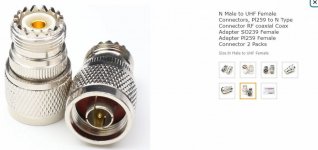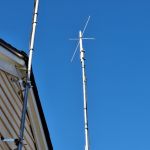- Forums
- Scanners, Receivers and Related Equipment Forums
- Antennas and Associated Hardware
- Scanner / Receiver Antennas
You are using an out of date browser. It may not display this or other websites correctly.
You should upgrade or use an alternative browser.
You should upgrade or use an alternative browser.
800 MHz UHF Vertcial VS. OmniX Scanner Base Antenna
- Thread starter galligan122
- Start date
prcguy
Member
An example for this might be you have a really weak hard to receive 800MHz signal on an Omni-X, changing to a 6dBd gain will make a very noticeable improvement with less noise. Going to a 9dBd gain will be even better. A signal that is only noise where you can’t make out any words on a Omni-X should be good copy on a 9dBd gain.Thank you for your response, as I have limited knowledge on the subject, but in reading about multi-range vs. dedicated 800 mhz antennas this seemed to be the answer. I didn’t know if this was an exception because of how it was built. When you say 0dBd, does that translate to not pulling in signals stronger and from farther away? I know others have stated they had success with the Omni-X, but I am unsure on how much “more” I’d get from a dedicated 800 MHz antenna
Thank you for the info. I am on the county line and one uses 800 MHz and the other uses 700 MHz. Most of what I want to hear is in the 800 range. Would I still hear the 700 frequency with the 800 antenna since I’m so close?An example for this might be you have a really weak hard to receive 800MHz signal on an Omni-X, changing to a 6dBd gain will make a very noticeable improvement with less noise. Going to a 9dBd gain will be even better. A signal that is only noise where you can’t make out any words on a Omni-X should be good copy on a 9dBd gain.
prcguy
Member
As an example, if an antenna is rated 824 to 896MHz I would expect it to work but with some degradation at 769MHz. Hard to predict how much. There are models that will cover both 700 and 800MHz.Thank you for the info. I am on the county line and one uses 800 MHz and the other uses 700 MHz. Most of what I want to hear is in the 800 range. Would I still hear the 700 frequency with the 800 antenna since I’m so close?
Ubbe
Member
It's a 3dB loss at 800MHz for a genuin LMR400 coax at 100ft. Not alarmingly much. Coax cost will be $150-$200. A more easy to install RG6 coax will cost $25 and will leave a lot of money to spend on amplifier, filters, attenuators and a splitter so that several scanners can be used and there will be zero attenuation from the antenna and some extra gain to overcome the high internal noise figure in a scanner.Maybe Ubbe could chime in here and assist. Thank You ubbe!
If a weak signal are received it could be lost in noise if a coax attenuates 3dB and can never be recovered again. If amplifying at the antenna you raise the signal level 10-15dB and at the other end you attenuate the signal as well as any added noise from the coax when electrons and molecules are forced to move to transport the RF signal.
RG6 coax
Amplifier low noise that can still handle strong signals
FM broadcast filter
Bias-T
1-2 splitter
4,7pF capacitor bridged with a 560 ohm resistor to make signals EQ balanced independent of frequency, inserted in the bias-T or splitter
Pigtail cables or quality adapters
/Ubbe
APX8000
Sarcastic Member
Anyone ever use one of those Child's Antenna Company antennas ?
I’ve got the OmniX Antenna with 40 feet of LMR 400 on a 1 story house in the L.A / O.C border
It gets the 700-800 frequencies OK. The OmniX really shines in the VHF, as with All Muti Band
Antennas there going to shine great in one band and everything else OK.
I’m also looking for a 700-800 Antenna. Pcrguy eBay’s recommendation got me interested.
Still open to a yagi like this one.
 theantennafarm.com
theantennafarm.com
It gets the 700-800 frequencies OK. The OmniX really shines in the VHF, as with All Muti Band
Antennas there going to shine great in one band and everything else OK.
I’m also looking for a 700-800 Antenna. Pcrguy eBay’s recommendation got me interested.
Still open to a yagi like this one.
760-870 MHz Yagi Antenna, 9 dBi, 6 Element Connector Type N Female
760-870 MHz Yagi Antenna, 9 dBi, 6 Element, Fully Welded
prcguy
Member
I have a few spare 800-900MHz 6dBi jobs that go down to 750MHz just fine and your not far from me. Got something to trade?I’ve got the OmniX Antenna with 40 feet of LMR 400 on a 1 story house in the L.A / O.C border
It gets the 700-800 frequencies OK. The OmniX really shines in the VHF, as with All Muti Band
Antennas there going to shine great in one band and everything else OK.
I’m also looking for a 700-800 Antenna. Pcrguy eBay’s recommendation got me interested.
Still open to a yagi like this one.
760-870 MHz Yagi Antenna, 9 dBi, 6 Element Connector Type N Female
760-870 MHz Yagi Antenna, 9 dBi, 6 Element, Fully Weldedtheantennafarm.com
still doing more research, must be 769 low & 850 high end.
Here is the link to Amazon with the above pictured connector:
The connector on the Omni X is N Female, so you would need a an adapter to N Male from your UHF Male. See above post.
Right.. the above post (above yours) is mine... so the adaptor I posted above is the correct one? The adaptor I am looking at has a UHF female so it would connect to my male UHF and then come out as the needed Nmale connection? Seems obvious.. but I wanted to double check!!The connector on the Omni X is N Female, so you would need a an adapter to N Male from your UHF Male. See above post.
prcguy
Member
If you have 700/800/900MHz frequencies you don't want PL-259s anywhere in your antenna system. Using an SO-239 to N adapter will not fix the loss problem.Question: I have some existing LMR400 cable with UHF Male connectors, is this the adapter I need to hook up to the OmniX N Female connector? (See attached pic)View attachment 172611
How much DB loss would you guess I would have if I used the PL-259 adaptor? (Just your best guess) I have maybe 50-75
feet of the LMR 400....
feet of the LMR 400....
prcguy
Member
Don't know, it would have to be measured. High quality silver/Teflon PL-259s are legitimately used in some equipment up to about 500MHz but cheaper connectors will show problems at a much lower frequency.How much DB loss would you guess I would have if I used the PL-259 adaptor? (Just your best guess) I have maybe 50-75
feet of the LMR 400....
Did you ever try these out?Anyone ever use one of those Child's Antenna Company antennas ?
APX8000
Sarcastic Member
I have not. Asking the same question.
Similar threads
- Replies
- 13
- Views
- 766
- Replies
- 2
- Views
- 200
- Replies
- 3
- Views
- 453




